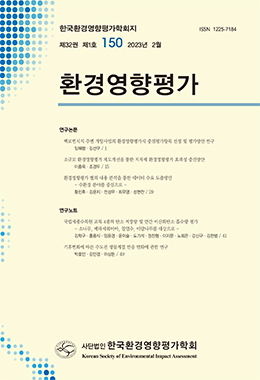본 연구는 세종특별시의 주요 도심 녹지인 국립세종수목원을 대상으로 신규 탄소흡수원으로서의 가능성을 확인하기 위해 수행되었다. 흉고직경 5.5cm 이상 소나무 794본과 가로수로 식재된 이팝나무 154본, 메타세쿼이아 216본, 칠엽수 172본 등 총 1,336본의 수목을 대상으로 4월부터 11월까지 현장조사와 지상 라이다 측정을 수행하였다. 조사 결과를 바탕으로 산림탄소상쇄제도에서 사용하고 있는 연간 이산화탄소 흡수량 추정식을 사용하여 탄소 저장량 및 연간 이산화탄소 흡수량을 산정하였다. 주요 수목 4종이 가장많이 분포하는 흉고직경 12cm 직경급의 탄소 저장량을 비교해본 결과, 이팝나무(0.0136tC/본), 소나무 (0.0126tC/본), 메타세쿼이아(0.0092tC/본), 칠엽수(0.0076tC/본) 순으로 나타났다. 그리고 20본을 대상으로 지상라이다 측정자료와 비교해 본 현장조사 자료는 수고 10.0cm, 흉고직경은 1.7cm 차이를 보였다 (p<0.05). 추후 정확하고 효율적인 측정방법에 대한 연구가 필요할 것으로 보인다. 또한 수목원에 식재된다른 종의 탄소 저장량 및 연간 이산화탄소 흡수량을 추가로 구축하면 수목원의 탄소흡수 효과를 홍보하고 국가 NDC 달성에 기여할 수 있을 것으로 판단된다. 장기적으로 도시숲 및 정원에 주로 사용되는 수종의 정확한 탄소 저장량 산정을 위해 주로 사용되는 교목이나 관목의 탄소흡수계수개발도 필요할 것으로 사료된다.
This study was conducted to confirm the possibility of a new carbon stock in the Sejong National Arboretum, a major urban greenspace in Sejong-si. This study involved field and ground surveys of 1,336 trees, including 794 Pinus densiflora trees with a diameter at breast height (DBH) of above 5.5cm, which are the most planted in the Sejong National Arboretum, Chionanthus retusus 154 trees planted, Metasequoia glyptostroboides 216 trees, and Aesculus turbinata 172 trees as street trees. Measurements were performed from April to November. Based on the results of the survey, the carbon storage and annual carbon stock were calculated using the annual carbon stock estimation equation used in the forest carbon offset projects. As a result of comparing the carbon stock of the 12cm diameter class, which is the most distributed of four major trees, it was found in the order of C. retusus (0.0136tC/tree), P. densiflora (0.0126tC/tree), M. glyptostroboides (0.0092tC/tree), and A. turbinata (0.0076tC/tree). In addition, the field survey measurement data compared with terrestrial LiDAR measurement data for 20 trees showed a difference of 10.0cm in tree height and 1.7cm in diameter at breast height (p<0.05). In the future, additional carbon stock and annual uptake of other species planted in the arboretum are expected to promote the carbon uptake effect of the arboretum and contribute to the achievement of the national NDC. In the long term, it is also necessary to develop the carbon uptake factor of trees and shrubs mainly used to calculate the exact carbon uptake amount of trees mainly used in urban forests and gardens.


